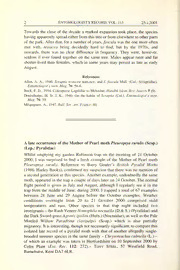
A late occurrence of the mother of pearl moth Pleuroptya ruralis (Scop.) (Lep.: Pyralidae) PDF
Preview A late occurrence of the mother of pearl moth Pleuroptya ruralis (Scop.) (Lep.: Pyralidae)
2 ENTOMOLOGISTS RECORD, VOL. 113 25.L2001 Towards the close of the decade a marked expansion took place, the species having apparently spread either from this tree or from elsewhere to other parts of the park. After that, for a number of years,fuscula was the one more often met with, testacea being decidedly hard to find; but by the 1970s, and onwards, there was no clear difference in frequency. They were, however, seldom if ever found together on the same tree. Males appear rarer and far shorter-lived than females, which in some years may persist as late as early August. References Allen, A. A., 1940. Scraptia testacea nom.nov. and S.fuscula Mull. (Col.: Scraptiidae). Entomologist's mon. Mag. 76: 56-8. Buck, F. D., 1954. Coleoptera: Lagriidae to Meloidae. HandbkIdent. Brit. Insects 5 (9). Donisthorpe, H. St. J. K., 1940. On the habits of Scraptia (Col.). Entomologist's mon. Mag. 76: 59. Mequignon, A., 1947. Bull. Soc. ent. France: 60. A late occurrence of the Mother of Pearl moth Pleuroptya ruralis (Scop.) (Lep.: Pyralidae) Whilst emptying my garden Robinson trap on the morning of 21 October 2000, I was surprised to find a fresh example of the Mother of Pearl moth Pleuroptya ruralis. Reference to Barry Goater's British Pyralid Moths (1986. Harley Books), confirmed my suspicion that there was no mention of a second generation in this species. Another example, undoubtedly the same moth, appeared in the trap a couple of days later on 24 October. The normal flight period is given as July and August, although I regularly see it in the trap from the middle of June; during 2000, I trapped a total of 67 examples between 28 June and 29 August before the October examples. Weather conditions overnight from 20 to 21 October 2000 comprised mild temperatures and rain. Other species in that trap night included two immigrants - the Rush VeneerNomophila noctuella (D.& S.) (Pyralidae) and the Dark Sword-grass Agrotis ipsilon (Hufn.) (Noctuidae), as well as the Pale Mottled Willow Paradrina clavipalpis (Scop.) which is also partially migratory. It is interesting, though not necessarily significant, to compare this isolated late record of a pyralid moth with that of another allegedly single- brooded summer species in the same family - Chrysoteuchia culmella (L.) - of which an example was taken in Hertfordshire on 10 September 2000 by Colin Plant (Ent. Rec. Ill: 272).- Tony Steel, 57 Westfield Road, Barnehurst, Kent DA7 6LR.
